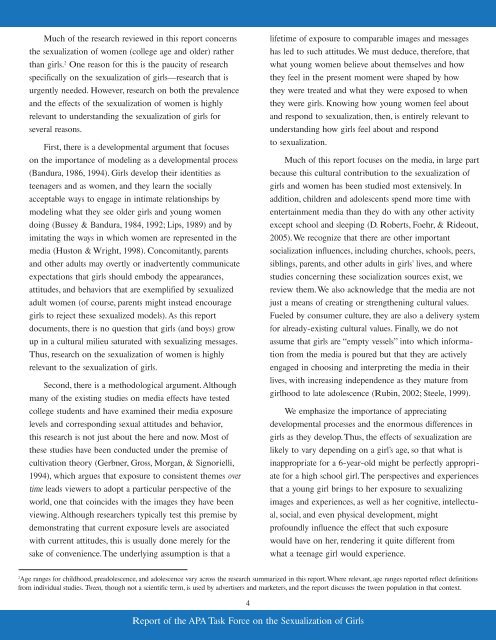SexualizationofWomen.. - Department of Psychology - York University
SexualizationofWomen.. - Department of Psychology - York University
SexualizationofWomen.. - Department of Psychology - York University
You also want an ePaper? Increase the reach of your titles
YUMPU automatically turns print PDFs into web optimized ePapers that Google loves.
Much <strong>of</strong> the research reviewed in this report concerns<br />
the sexualization <strong>of</strong> women (college age and older) rather<br />
than girls. 2 One reason for this is the paucity <strong>of</strong> research<br />
specifically on the sexualization <strong>of</strong> girls—research that is<br />
urgently needed. However, research on both the prevalence<br />
and the effects <strong>of</strong> the sexualization <strong>of</strong> women is highly<br />
relevant to understanding the sexualization <strong>of</strong> girls for<br />
several reasons.<br />
First, there is a developmental argument that focuses<br />
on the importance <strong>of</strong> modeling as a developmental process<br />
(Bandura, 1986, 1994). Girls develop their identities as<br />
teenagers and as women, and they learn the socially<br />
acceptable ways to engage in intimate relationships by<br />
modeling what they see older girls and young women<br />
doing (Bussey & Bandura, 1984, 1992; Lips, 1989) and by<br />
imitating the ways in which women are represented in the<br />
media (Huston & Wright, 1998). Concomitantly, parents<br />
and other adults may overtly or inadvertently communicate<br />
expectations that girls should embody the appearances,<br />
attitudes, and behaviors that are exemplified by sexualized<br />
adult women (<strong>of</strong> course, parents might instead encourage<br />
girls to reject these sexualized models). As this report<br />
documents, there is no question that girls (and boys) grow<br />
up in a cultural milieu saturated with sexualizing messages.<br />
Thus, research on the sexualization <strong>of</strong> women is highly<br />
relevant to the sexualization <strong>of</strong> girls.<br />
Second, there is a methodological argument. Although<br />
many <strong>of</strong> the existing studies on media effects have tested<br />
college students and have examined their media exposure<br />
levels and corresponding sexual attitudes and behavior,<br />
this research is not just about the here and now. Most <strong>of</strong><br />
these studies have been conducted under the premise <strong>of</strong><br />
cultivation theory (Gerbner, Gross, Morgan, & Signorielli,<br />
1994), which argues that exposure to consistent themes over<br />
time leads viewers to adopt a particular perspective <strong>of</strong> the<br />
world, one that coincides with the images they have been<br />
viewing. Although researchers typically test this premise by<br />
demonstrating that current exposure levels are associated<br />
with current attitudes, this is usually done merely for the<br />
sake <strong>of</strong> convenience.The underlying assumption is that a<br />
lifetime <strong>of</strong> exposure to comparable images and messages<br />
has led to such attitudes.We must deduce, therefore, that<br />
what young women believe about themselves and how<br />
they feel in the present moment were shaped by how<br />
they were treated and what they were exposed to when<br />
they were girls. Knowing how young women feel about<br />
and respond to sexualization, then, is entirely relevant to<br />
understanding how girls feel about and respond<br />
to sexualization.<br />
Much <strong>of</strong> this report focuses on the media, in large part<br />
because this cultural contribution to the sexualization <strong>of</strong><br />
girls and women has been studied most extensively. In<br />
addition, children and adolescents spend more time with<br />
entertainment media than they do with any other activity<br />
except school and sleeping (D. Roberts, Foehr, & Rideout,<br />
2005).We recognize that there are other important<br />
socialization influences, including churches, schools, peers,<br />
siblings, parents, and other adults in girls’ lives, and where<br />
studies concerning these socialization sources exist, we<br />
review them.We also acknowledge that the media are not<br />
just a means <strong>of</strong> creating or strengthening cultural values.<br />
Fueled by consumer culture, they are also a delivery system<br />
for already-existing cultural values. Finally, we do not<br />
assume that girls are “empty vessels” into which informa-<br />
tion from the media is poured but that they are actively<br />
engaged in choosing and interpreting the media in their<br />
lives, with increasing independence as they mature from<br />
girlhood to late adolescence (Rubin, 2002; Steele, 1999).<br />
We emphasize the importance <strong>of</strong> appreciating<br />
developmental processes and the enormous differences in<br />
girls as they develop.Thus, the effects <strong>of</strong> sexualization are<br />
likely to vary depending on a girl’s age, so that what is<br />
inappropriate for a 6-year-old might be perfectly appropri-<br />
ate for a high school girl.The perspectives and experiences<br />
that a young girl brings to her exposure to sexualizing<br />
images and experiences, as well as her cognitive, intellectu-<br />
al, social, and even physical development, might<br />
pr<strong>of</strong>oundly influence the effect that such exposure<br />
would have on her, rendering it quite different from<br />
what a teenage girl would experience.<br />
2 Age ranges for childhood, preadolescence, and adolescence vary across the research summarized in this report.Where relevant, age ranges reported reflect definitions<br />
from individual studies. Tween, though not a scientific term, is used by advertisers and marketers, and the report discusses the tween population in that context.<br />
4<br />
Report <strong>of</strong> the APA Task Force on the Sexualization <strong>of</strong> Girls

















